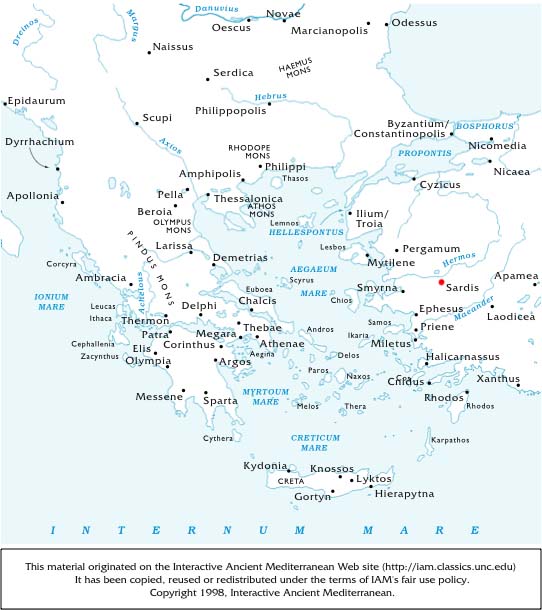One of the most ancient and famous cities of Asia Minor, and the capital of the great Lydian monarchy, stood on the southern edge of the rich valley of the Hermus, at the northern foot of Mount Tmolus, on the little river Pactolus, 30 stadia (three geographical miles) south of the junction of that river with the Hermus ( Herod.v. 101). On a lofty precipitous rock, forming an outpost of the range of Tmolus, was the almost impregnable citadel, which some suppose to be the Hydé of Homer, who, though he never mentions the Lydians or Sardis by name, speaks of Mount Tmolus and the Lake of Gyges ( Il.xx. 385). [p. 1412] The erection of this citadel was ascribed to Meles, an ancient king of Lydia. It was surrounded by a triple wall, and contained the palace and treasury of the Lydian kings. At the downfall of the Lydian Empire, it resisted all the attacks of Cyrus, and was only taken by surprise. The story is told by Herodotus, who relates other legends of the fortress. The rest of the city, which stood in the plain on both sides of the Pactolus, was very slightly built, and was repeatedly burned down, first by the Cimmerian Gauls in the seventh century B.C., then by the Greeks in the great Ionic revolt, and again, in part at least, by Antiochus the Great (B.C. 215); but on each occasion it was restored.Under the Persian and Greco-Syrian Empires, it was the residence of the satrap of Lydia. The rise of Pergamum greatly diminished its importance; but under the Romans it was still a considerable city, and the seat of a conventus iuridicus (Pliny , Pliny H. N.v. 111). In the reign of Tiberius, it was almost entirely destroyed by an earthquake, but was restored by the aid of that emperor ( Tac. Ann.ii. 47). It was one of the seven Christian Churches of the province of Asia. In 1402 it was totally demolished by Tamerlane; but the triple wall of its acropolis can still be traced, and there are remains of the temple of Cybelé, a theatre, the stadium, and other structures, together with some vestiges of the necropolis, four miles distant from the city across the river Hermus. The site of the city is still called Sart. (Harpers Dictionary of Classical Antiquities, 1898)
